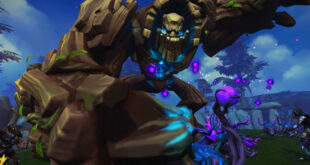To say that Niantic’s first year as an independent company was special would be massively underselling it.
In October 2015, the firm spun itself out from tech giant Google, where it had been run as one of the company’s start-ups. The following July, Niantic released Pokmon Go.
The title brought the much-loved Pokmon franchise to mobile devices, owned by most people these days. It was free-to-play and therefore meant that everyone could play it.
Pokmon Go went on to have roughly 44m active users at its peak, and helped Nintendo shares soar – before the company told shareholders it wasn’t responsible for the game. It dominated headlines and popular culture and, for a brief time, changed how society functioned.
Its effects were felt further than Pokmon Go itself. The game helped UK sales of Nintendo’s 3DS console rise by over 200 per cent in its first week.
But even Niantic couldn’t predict how big Pokmon Go would be.
We had some really good early indicators of demand, or the appeal, of the game when we did the announcement in September 2015 in Tokyo with our CEO John Hanke, Mr Ishihara from The Pokmon Company, Miyamoto-san from Nintendo and Masuda-san from Game Freak,” Niantic CMO Mike Quigley (pictured, above) says.
We saw the initial reaction to that, which was quite positive. We also released the concept trailer. The fan reaction to that, from both the active Pokmon player, the lapsed Pokmon fan, the Ingress players and broader gamers at large was quite positive, so that was one early initial sign that we thought we might have something special here. More importantly, we started to do our field test, a closed beta in classic gaming terms, in March in Japan, so we started getting learnings there from a sub-set of our community in Japan. We rolled that out to New Zealand and Australia in April. It wasn’t just the classic bug fixes, but also feedback on the core game loops.
Fast forward to now and there have been a lot of polishes and things we have done, and some new features we have introduced like the Daily Bonus that hopefully will continue over time to improve the game. The combination of that early feedback plus the field test made us think that the response to Pokmon Go could be pretty big. I’d be completely lying if I said we anticipated the success it had and that we thought it would explode in the way that it did.”
As well as being a massive deal for Niantic and The Pokmon Company, Pokmon Go was also – arguably – the first demonstration of augmented reality to the general population. The title was also buoyed by the success of Niantic’s previous title, Ingress, which launched four years ago and has been installed 20m times.
We always think of Ingress as a four-year R&D project,” Quiley says.
We had a lot of learning from it on the technical and operations side, things like customer support, marketing, community etc. We learnt a lot of things that we applied here. Pokmon Go is probably the first at-scale example of what the potential of AR technology is.
"We would still call it ourselves AR-light, there’s so much more that can be done and there’s obviously some big investments by some big companies around AR. We’re just pleased with the computing power we have on these amazing devices, both iOS and Android-based phones, that we are able to bring some of that to life today without having to have expensive head gear, high-end systems or being tethered.
That’s never going to work for us. We do not want people indoors on sofas. We want them out and about in their neighbourhoods exploring. We’re thankful for the computing power of the mobile device that can at least bring that initial experience to life. There’s a lot more that can be done and so we’re excited about the potential. It was a good proof point for what AR can be. There’s more to come.”
"I’d be completely lying if I said we anticipated the success it had and that we thought it would explode in the way that it did."
Mike Quigley, Niantic
One of the other massive moves in augmented reality is Microsoft’s HoloLens device, which was shown off on at E3 2015 with a frankly stunning Minecraft demo. And while Niantic isn’t in a position to announce anything, Quigley says the firm is interested in teaming up with other companies, as it has Apple, in the future.
Microsoft HoloLens, Magic Leap… there’s a lot of amazing teams working on some cool tech,” he says.
We’re just looking forward to seeing what comes from that and what’s possible. Like a lot of those technologies, we have to see what will emerge and how accessible they are.
We announced that we are going to be doing integration on to the Apple Watch, so that would be our first foray in partnering with a third-party. What we do with other partners beyond Apple is to be announced, but it’s a signal that we are going to continue to talk to those partners and if it makes sense to work with them, we’ll certainly entertain those conversations.”
Pokmon Go’s user base has predictably dropped off from its 44m player height. Headlines in August said that the title had dropped 35 per cent to 29m, with some coming to conclusion that the game was in trouble – yet 35 per cent dip for a mobile game’s user base in the months after launch is actually impressive.
There was a lot of noise about the drop-off in user base,” Quigley says.
Some of it was bound to happen – things like kids going back to school in the Northern Hemisphere. There are all sorts of things as you go from summer to autumn. It is what it is, people are going to say what they’re going to say. We just need to stay focused on our strategy which is to continue to add new features, continue to listen to the community, what are the things that they really want us to get to and try to get to them as early as we can with a high quality bar.
The Pokmon Company is a fantastic partner. We work very closely with them and we want to do right by the brand and what Niantic’s expectations are, because we have our own very high quality bar as well. Sometimes I’ll admit it’s painful to read some of those headlines, but you honestly have to not get distracted. We have now mastered the art of not getting distracted by negative headlines and sentiment because we’re really confident in what we are doing.
This is where the four-year history of Ingress and the company gives us a lot of confidence. We’re excited and very humbled by what happened over the summer, but we have a longer term plan so we’re trying not to be distracted by anything else.
We’re pleased with the average daily users we saw from the Halloween promotion. And we’re just getting started on those things – that’s probably an indicator of things to come in terms of holiday and promotions.”
Promotions and player events are just two of the ways that Niantic plans to retain users long-term for Pokmon Go, much as it has with Ingress. This is a promising strategy, too, as the firm’s recent Halloween promotion for Pokmon Go saw daily active users rise 13.2 per cent week-on-week globally.
We’ll have more details on those in t

 MCV/DEVELOP News, events, research and jobs from the games industry
MCV/DEVELOP News, events, research and jobs from the games industry



